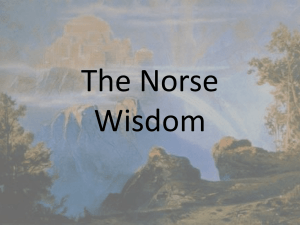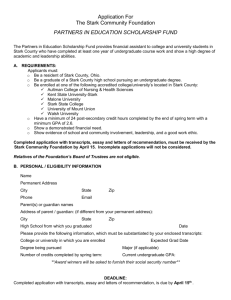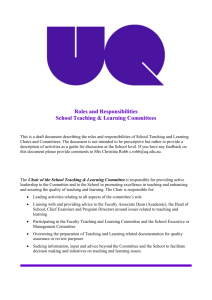Catelyn Stark A Game of Thrones: The Norse and the North In
advertisement
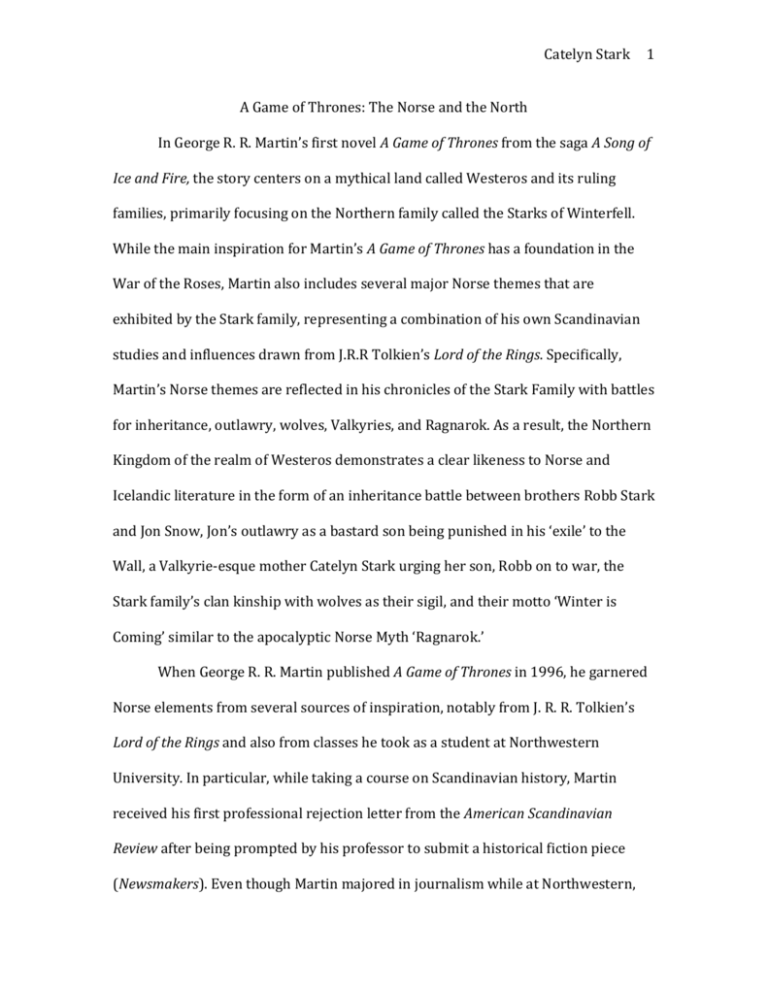
Catelyn Stark 1 A Game of Thrones: The Norse and the North In George R. R. Martin’s first novel A Game of Thrones from the saga A Song of Ice and Fire, the story centers on a mythical land called Westeros and its ruling families, primarily focusing on the Northern family called the Starks of Winterfell. While the main inspiration for Martin’s A Game of Thrones has a foundation in the War of the Roses, Martin also includes several major Norse themes that are exhibited by the Stark family, representing a combination of his own Scandinavian studies and influences drawn from J.R.R Tolkien’s Lord of the Rings. Specifically, Martin’s Norse themes are reflected in his chronicles of the Stark Family with battles for inheritance, outlawry, wolves, Valkyries, and Ragnarok. As a result, the Northern Kingdom of the realm of Westeros demonstrates a clear likeness to Norse and Icelandic literature in the form of an inheritance battle between brothers Robb Stark and Jon Snow, Jon’s outlawry as a bastard son being punished in his ‘exile’ to the Wall, a Valkyrie-esque mother Catelyn Stark urging her son, Robb on to war, the Stark family’s clan kinship with wolves as their sigil, and their motto ‘Winter is Coming’ similar to the apocalyptic Norse Myth ‘Ragnarok.’ When George R. R. Martin published A Game of Thrones in 1996, he garnered Norse elements from several sources of inspiration, notably from J. R. R. Tolkien’s Lord of the Rings and also from classes he took as a student at Northwestern University. In particular, while taking a course on Scandinavian history, Martin received his first professional rejection letter from the American Scandinavian Review after being prompted by his professor to submit a historical fiction piece (Newsmakers). Even though Martin majored in journalism while at Northwestern, Catelyn Stark 2 his bodies of work as a writer predominantly reflect his interests in medieval and Scandinavian history. Consequently, when Martin began writing A Game of Thrones, he acknowledged that the largest source of inspiration was Tolkien’s Lord of the Rings, which also features similar Scandinavian themes, and the English War of the Roses (Newsmakers). However, when Martin borrowed elements of warfare from Tolkien with “the kingdoms of men [and] dark armies of…. ringwraiths,” (Serwer) he modified the material to reflect his own interpretations of Scandinavian history. As a result, while Tolkien’s characters are either starkly villains or heroes, Martin’s heroes are also villains, being “old bullies who father… children out of wedlock” (Serwer) and therefore closer to Viking characters who exhibit factions of both good and evil. In addition, Martin’s more distinctly Norse characters contend with bastard sons fighting trueborn sons, and involve mistresses, and other marital relations reminiscent of the Viking Sagas of the Volsungs or People of Laxardal. Ultimately, although Martin consciously copies elements of war and the battle for inheritance from Tolkien’s Lord of the Rings, he also utilizes his own knowledge of Norse mythology in A Game of Thrones with the inclusion of outlawry as a form of punishment, bastardry, Valkyries, and an apocalyptic ‘Ragnarok’ doomsday. A Game of Thrones takes place in the Northern providence of Winterfell, a large portion of the land of Westeros. Specifically, the story centers on Lord Eddard Stark, the Lord of Winterfell and Warden of the North, and his family’s trials in the aftermath of a rebellion against the Targaryens, the previous ruling dynasty of Westeros. In particular, the Starks of Winterfell are afforded distinct characteristics from the other ruling families of Westeros, especially their doomsday motto ‘Winter Catelyn Stark 3 is Coming’ ultimately preparing for an impending decade-long winter, but also for their sigil, the direwolf. The Stark children Jon, Robb, Sansa, Bran, Arya, and Rickon all exhibit the kinship with wolves as six direwolf pups are found in the forest, four boys and two girls, precisely match the genders of the children themselves. When Eddard leaves for Winterfell for the job of Hand of the King in the capital city of Westeros, he leaves behind two fifteen year-old boys in his stead – his legitimate heir, Robb, born to his wife Catelyn Stark, and his bastard born son, Jon Snow. Both sons are in potential competition for the seat of Winterfell should Eddard die. Catelyn is preoccupied with asserting Robb’s trueborn right to inherit Winterfell, offering him guidance as the future ruler in a Valkyrie-esque manner, and consistently downplays and undermines Jon’s rights to Winterfell, working directly to remove him as a potential competitor. Bastard Jon Snow is then sent (effectively exiled) to the farthest North region known as the Wall, joining the brotherhood of the Night’s Watch whose vows mean that he can make no claim to Winterfell, but instead faces his own imminent threats from the undead people and wildlings beyond the Wall, battling alongside other criminals and outlaws of society. When Eddard is taken as a political prisoner in the capital of Westeros, Catelyn focuses on aiding Robb’s quest to rescue his father rather than defending his claim to the North, by gathering together a force of subservient lords of the North, like the Greyjoys, and negotiating loyalties amongst other houses. However, as the novel comes to an end, Eddard is unjustly executed during a power grab for the Iron Throne of Westeros, making Robb’s claim to the inheritance of the North critical. Not only does Robb then take up the physical seat at Winterfell, Catelyn Stark 4 he also takes on the task of avenging his father’s death, a job that Jon, now apart of the Nights’ Watch Brotherhood, is unable to take. Moreover, Robb asserts himself by taking the mantle of King of the North, under the suggestion from his mother and fellow lords, thereby separating his domain from the King in Westeros. As a result, the novel concludes with Robb fighting his way to the Westeros capital King’s Landing, with his mother Catelyn at his side, while Jon fights off undead White Walkers far North of the wall, alluding to the impending ‘Winter [that] is Coming,’ The battle for the inheritance of Winterfell between Robb Stark and Jon Snow is one of the explicitly Norse themes immediately evident in A Game of Thrones. Specifically, the battle between Robb and Jon begins early, with the differences emphasized in their physical features, names, and status, but places them as equals due to their blood relationship. In terms of birth order, Robb and Jon are set on a collision course because they are born in the same year, Robb to Catelyn, and Jon, brought home by Ned from an affair with a supposed prostitute. In particular, Robb and Jon’s competition echoes a similar instance within an Icelandic Saga called the People of Laxardal, between Hoskuld and his two sons, Thorliek and Olaf Peacock. While Thorliek is Hoskuld’s legal son, Hoskuld favors his bastard-born, Olaf, stating he had “never seen a handsomer or more distinguished-looking child,” (Smiley 289). Not only does Hoskuld’s favoritism create animosity between Thorliek and Olaf’s mothers, but it also lessens the significance of the sons’ blood, since they are both recognized as Hoskuld’s sons, and more emphasis on their later accomplishments. As with Hoskuld and Olaf, Eddard favors Jon, not just in bringing his bastard home from the war, but “calling him ‘son’ for the North to see,” (Martin 54) and going as Catelyn Stark 5 far as to defend Jon from his wife Catelyn when she tries to send Jon away, stating “he is [of] my blood” (Martin 54). Moreover, as the boys grow up together they compete physically in racing horses and play-fighting, thereby continually testing one another where “Robb is a stronger lance, [and Jon is] the better sword,” (Martin 44). In addition, Robb and Jon differ in physical appearance, name, and status. Robb is “big and broad… with his mother’s coloring, the fair skin, red-brown hair, and blue eyes of the Tullys of Riverrun,” (Martin 13) whereas Jon is dark, with grey eyes, looking “more like Ned than any of [his] trueborn sons,” (55). Robb and Jon are known by different last names too, which is “the simplest form of inheritance… children receive the names… of their parents” as Robb’s surname is Stark, whereas Jon’s is Snow (Drout 204). Their individual status is also marked at court; as a Prince of Winterfell, Robb is seated “with the royal children” and other nobles, but Jon takes “his place on the bench among the younger squires,” (41). However, for all their differences, Robb and Jon share Stark blood, which equalizes them in terms of rights of inheritance. Within the Norse inheritance system there are two criteria where “some may benefit more from a greater emphasis on blood, others might gain more under a more deeds-focused system,” (Drout 203). As a result because “blood inheritance was not enough” (Drout 206) Robb and Jon’s deeds will ultimately determine who inherits Winterfell. That test occurs when Eddard is taken prisoner and executed. Both Robb and Jon individually attempt to avenge their father, but Robb is more successful, raising an army and riding to Kings’ Landing, while Jon is prevented by his vows to Nights’ Watch from riding to the capital, having been ‘outlawed’ by Catelyn Stark. Catelyn Stark 6 Jon’s outlawry by Catelyn Stark is another of the major Norse elements included by Martin to demonstrate his knowledge of Scandinavian history. Specifically, since Catelyn sees Jon as a threat to Robb’s ‘rightful’ inheritance of Winterfell, she mandates that Eddard send Jon into an ‘exile’ at the farthest North of Westeros, to the Wall. Consequently, Jon’s outlawry to the Wall represents a common “prerogative of the crown… often used as a political weapon to remove enemies or powerful rivals… by exiling them,” (Lindahl, McNamara, Lindow 748). The Wall, essentially a massive wall of ice that divides the lands of Westeros from the Far North, is guarded by a brotherhood of exiles and outlaws called the Night’s Watch. The Night’s Watch itself includes some men of noble rank, a category that Jon fits, but also serves as a place of banishment for Westeros’ criminals, with “debtors, poachers, rapers, thieves, bastards… and all other monsters” (Martin 104), all of whom have chosen exile to the Wall as their punishment instead of death. Similarly in Norse literature “outlawry remained a common punishment for lawbreakers, particularly for those who committed crimes against society,” (Lindahl, McNamara, Lindow 748) emphasized in the Saga of the Volsungs with the exile of Sigi for killing his kinsmen (Byock 35). Although Jon is not convicted of killing his kinsmen like Sigi, his outlaw sentence to the Wall and the vows he takes to become a member of the Nights’ Watch represent a critical factor that prevents him from contesting with Robb as the vows state “I shall take no wife, hold no lands, father no children… wear no crowns and win no glory,” (Martin 436) therefore voiding Jon’s claims to the throne of Winterfell. In effect, Jon’s outlawry to the Wall alongside other criminals of Catelyn Stark 7 society removed him as a political threat to Robb’s inheritance and his vow to Night’s Watch solidifies his permanent exile. However, Catelyn Stark’s actions in Jon’s outlawry reflect another important aspect of Norse mythology regarding the use of Valkyries. Traditionally, Valkyries were “female spirits… who wait on the warriors in Valhalla…[carrying] out Odin’s commands while battles rage,” (Davidson 61). Although Catelyn never explicitly fights on the battlefield in defense of her son, Robb, she acts as a Valkyrie in several other ways by guiding Robb as a young hero, inciting Robb to seek revenge for Eddard’s execution, and even strategizing Robb’s war plans. In the first instance, not only does Catelyn advocate that Jon to be sent to the Wall, thus defending Robb’s claim to Winterfell, but she also assists in Robb’s transition to becoming the Lord of Winterfell, “[making] him part of councils” (Martin 54). Her guidance of Robb validates her as a guardian spirit, a different type of Valkyrie, “encourage[ing] and support[ing] young warriors, especially princes, throughout life” (Lindahl, McNamara, Lindow 1015). Furthermore, when Eddard is executed, Catelyn performs a “hvöt… a lament for the deceased” (Borovsky 16), mourning the loss of her husband and old life, calling for vengeance in front of Robb’s war council. Thus, after her public lament, Catelyn’s role as a Valkyrie extends into the traditional role in warfare when she watches Robb’s battles “high on a ridge [and listens to] the hiss of arrows, the thunder of drums,” (Martin 584). When the battle ends, Catelyn even issues commands to Robb’s soldiers to take Robb’s prisoner, Jamie Lannister, “away and put him in irons,” (Martin 585). Although Catelyn never actually stands on a battlefield, she clearly acts as a Norse Valkyrie by defending Robb and his claims to Catelyn Stark 8 Winterfell, inciting him to seek revenge for his father’s death, and commanding his troops. Separate from fighting over inheritance, outlawry, or Valkyries, the Stark family’s sigil, the direwolf, also demonstrates a Norse influence whereby the wolf epitomizes two distinct factions of the Starks, and acts as a guardian spirit to the Stark children. The direwolf is depicted as “grey… racing across an ice-white field” (Martin 12) on the family banners. While the wolf has a negative connotation, as an “archetype of chaos” (Lindahl, McNamara, Lindow 1057), there are actually two ideologies surrounding the wolf in Norse myth including a “wolf beneficent… as Odin’s noble guardian” (1057) and “wolf malevolent” (1057). In particular, when the Stark men come across a litter of direwolf pups in the woods, the pups match with both the children’s gender, and the divisions of nobility in the family by their color. There are “five pups, three male, and two female” (Martin 16) that match up with the trueborn three Stark boys and two Stark girls, plus a sixth pup, almost left behind because he is so far from the litter, that symbolizes Jon. In their color, the pups signify the divisions of status between the trueborn children and bastard-born Jon because the sixth pup has “white fur [with piercing red eyes] where the rest of the litter was grey” (Martin 17). In essence, they divide the noble children, like Odin’s guardians, from the ‘malevolent’ bastard. Subsequently, as the wolves grow, despite the status divisions, all six become guardians to their individual Stark child. Indeed, one instance that epitomizes the Stark connections to their wolves occurs when Jon is under a verbal attack from Tyrion Lannister. Jon turns away, unable to respond verbally against the lord for fear of retaliation, but his direwolf, Ghost, Catelyn Stark 9 lunges at Tyrion, getting between them, not growling but “looking at him with those bright red eyes,” (Martin 105) attacking Tyrion physically where Jon cannot. Therefore, the Stark family direwolf sigil represents one part of a twofold inference of Norse mythology, where the wolves mirror the children’s identities and serve as their guardians. The Stark family motto ‘Winter is Coming’ represents another clear inference to Norse mythology by specific parallels to the doomsday legend of ‘Ragnarok.’ For the Starks, their house ‘words’ represent the long-standing prediction of a mass winter sweeping across Westeros, where the undead rise, and the apocalypse commences. Similarly, ‘fimbulvetr,’ a precedent to ‘Ragnarok’ reflects a “catastrophic winter… with snow from every quarter, great frosts, and sharp winds… pitting brother against brother,” (Lindahl, McNamara, Lindow 63) which echoes the Stark’s words. Even the idea of the undead White Walkers, although not specifically referenced in fimbulvetr, alludes to two separate Norse beliefs in the draugr, Scandinavian ghosts, and the warriors of Valhalla that come to fight at Ragnarok alongside Odin. While in the Night’s Watch, Jon Snow comes across one of these White Walkers when he is standing guard one night, seeing “a shadow in the shadows… eyes [shining] with icy blue radiance” (Martin 473). When neither his sword, nor wolf can kill the dead man, Jon resorts to fire to defeat the animated corpse. Coincidently, the White Walkers resemble Scandinavian legends of the draugr, “Scandinavian ghosts, or… animated corpses that frequently come out of their barrows, and walk… [occurring] frequently in the evening” (Chadwick 54). Moreover, the White Walkers can be warriors too, as is the corpse that Jon faces, Catelyn Stark 10 reproducing the notion of the ‘Ragnarok’ Valhalla warriors, since “while Odin [is not] exclusively the host of those fallen in battle… there is always a dimension to his involvement with the dead” (Wanner 336). As a result, the Stark words ‘Winter is Coming’ has a multi-faceted connection to Norse mythology, not just with the connection to fimbulvetr and Ragnarok, but also with the inclusion of White Walkers to symbolize Scandinavian ghosts and warriors of Valhalla. In A Game of Thrones, George R. R. Martin drew extensively from knowledge acquired during his Scandinavian studies at university when he created the Stark family and North region in the land of Westeros. Consequently, there are several evident Norse elements incorporated within the story, such as the concepts of inheritance, outlawry, Valkyries, wolves, and Ragnarok. Specifically, the battle for inheritance between half-brothers Robb Stark and Jon Snow parallels the Icelandic brothers Thorliek and Olaf Peacock. Similarly, Jon’s outlawry to the Wall is distinctly Norse since it accomplishes both his removal from the line of inheritance and initiation into a clan of outlaws called the Night’s Watch. Catelyn Stark is also portrayed as a Valkyrie through guiding Robb to extract vengeance for his father’s death. Finally, the very symbols of the Stark family have direct links to Norse mythology as the direwolf sigil is both reminiscent of Odin’s guardians, and serves as a badge that forewarns the impending doomsday winter. Works Cited: Borovsky, Zoe. "Never in Public: Women and Performance in Old Norse Literature." The Journal of American Folklore 112.443 (1999): 6-39. American Folklore Society. Web. 25 Feb. 2015. Catelyn Stark 11 Byock, Jesse L., trans. The Saga of the Volsungs: The Norse Epic of Sigurd the Dragon Slayer. London: Penguin, 1999. Print. Chadwick, N. K. "Norse Ghosts (A Study in the Draugr and the Haugbúi)." Folklore 57.2 (1946): 50-65. Taylor & Francis Group. Web. 25 Feb. 2015. Davidson, H.R. Ellis. Gods and Myths of Northern Europe. London: Penguin, 1964. Print. Drout, Michael D. "Blood and Deeds: The Inheritance Systems in 'Beowulf'" Studies in Philology 104.2 (2007): 199-226. The University of North Carolina Press. Web. 25 Feb. 2015. “George R.R. Martin.” Newsmakers. Vol. 3. Detroit: Gale 2011. Biography in Context. Web. 4. Mar. 2015 Lindahl, Carl, John McNamara, and John Lindow. Medieval Folklore: An Encyclopedia of Myths, Legends, Tales, Beliefs, and Customs. Santa Barbara (California): ABC-Clio, 2000. Print. Martin, George R. R. A Game of Thrones. New York: Bantam, 1996. Print. Serwer, Adam. “A Liberal’s Guide to Middle Earth: HBO’s New Show Game of Thrones Goes Beyond the Black and White of Good Versus Evil and Delves Into the Grey.” The American Prospect 22.4 (2011): 33+. Biography in Context. Web. 4 Mar. 2015. Smiley, Jane. The Saga of Icelanders. New York: Penguin Group, 2000. Print. Wanner, Kevin J. "Gods on the Margins: Dislocation and Transience in the Myths of Óδinn." History of Religions 46.4 (2007): 316-50. The University of Chicago Pres. Web. 25 Feb. 2015.
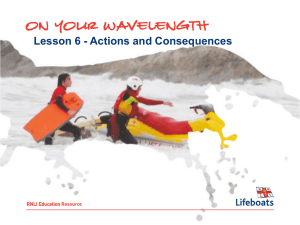
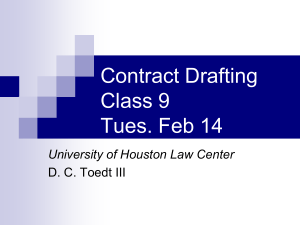
![[Company Name] Certificate of Completion](http://s2.studylib.net/store/data/005402466_1-8a11f4ced01fd5876feee99f8d8e6494-300x300.png)
